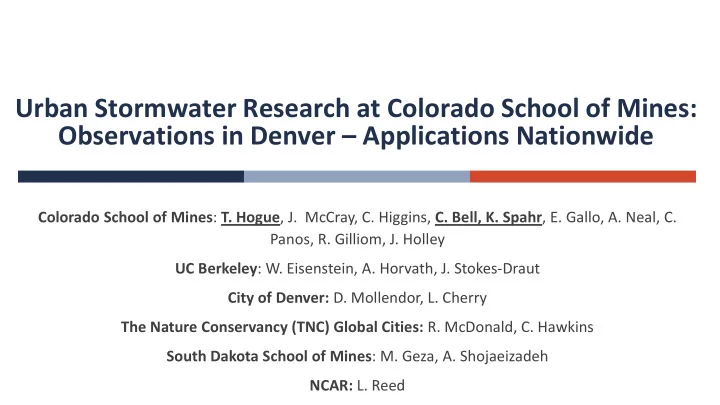

Urban Stormwater Research at Colorado School of Mines: Observations in Denver – Applications Nationwide Colorado School of Mines : T. Hogue , J. McCray, C. Higgins, C. Bell, K. Spahr , E. Gallo, A. Neal, C. Panos, R. Gilliom, J. Holley UC Berkeley : W. Eisenstein, A. Horvath, J. Stokes-Draut City of Denver: D. Mollendor, L. Cherry The Nature Conservancy (TNC) Global Cities: R. McDonald, C. Hawkins South Dakota School of Mines : M. Geza, A. Shojaeizadeh NCAR: L. Reed
Overview of Regional Projects Stormwater capture and treatment in Denver’s Berkeley neighborhood Impacts of Denver infill development on city greenness Integrated decision support tool for grey/green/hybrid stormwater infrastructure
Denver’s Berkeley Neighborhood Feasibility study to model and implement green infrastructure to treat increased stormwater due to infill in Denver Neighborhoods Utilize Models to Design Treatment Build Land Cover Evaluate Stormwater Systems to Capture Development Models Change and Re-use Water Collaborative project between ReNUWIt/CSM and City and County of Denver
Example of Infill Development
Example of Infill Development
Simulating Impacts on Hydrology Land use change SWMM hydrologic model Impacts on stream flow, water quality
Use Projections to Design BMP Use simulated hydrology post infill to design size of treatment train Use observed water quality to design biofilter media Filter Media Schematic Proposed Treatment Train Location
Vegetation Change in Denver Denver was fastest growing city in America in 2015 Minimum 0.3% Annual Increase in Infill Development by 2035 Importance of Greenness: Importance control of urban heat island effect Implications for air temperatures and outdoor water use
i-DST: Decision Support Tool for Stormwater Infrastructure EPA RFP: “ National Priorities: Life Cycle i-DST Six Hydrologic Costs of Water Infrastructure Modules: Alternatives” • Install • Operation Runoff + Response: Develop an integrated, • Maintenance Conveyance Life-cycle Cost Pollutant • Fees Assessment: Loading scalable, decision support tool ( i-DST ) for grey, green, and hybrid infrastructure PLANNING Social costs + Components: benefits Climate Siting Change life-cycle cost assessment (LCCA) with traditional costs/benefits AND co-benefits of ecosystems Hydrologic modules Additional Utilities: Siting utility Optimization and Uncertainty Optimization Grey Green Assessment Infrastructure Infrastructure Uncertainty assessment
Hydrologic Modules Runoff and pollutant loading. Conveyance through Six Hydrologic Modules: drainage network. Runoff + Conveyance Pollutant Loading We will provide simple, sub-hourly model. But users can also output from any hydrologic model as long as time series are formatted Climate Siting We will provide utility for that Change Grey + green infrastructure changing water balance and pollutant loading Climate change projections Grey Green Infrastructure Infrastructure SWMM CAT scalars
Life-Cycle Cost Assessment (LCCA) Objective: Fully understand the life-cycle decisions by quantifying direct and indirect costs and benefits: •Install Economic •Operation Life-cycle Cost Assessment: •Maintenance Life-cycle costs (construction, operation, •Fees maintenance, end of life). Environmental benefits Flood control / TMDL compliance Social Social costs + Green infrastructure may create livability benefits benefits Increased property values, biodiversity, public health Institutional barriers The core will be the UC Berkeley WEST tool for life cycle assessment
Other Utilities Optimization Ensure design meets regulations, and user-defined constraints Minimize both direct and holistic life cycle costs Additional Uncertainty assessment Utilities: • Optimization Provide a range of possible performance Especially valuable as there is intrinsic uncertainty due to • Uncertainty Assessment climate change projections and GI performance Performance Cost
i-DST: Scalable and region-specific Site Scale Tool will be developed at a individual site scale: i-DST-SB “SB” = S ite or B usiness scale Excel platform for ease of use Will include runoff + pollutant load module, as well Sewershed as reductions from GI Also, full model will harness more advanced runoff model for applicability at sewershed Regional Application scale Model will use region-specific data on loading, GI performance, cost, materials and climate change so it can be used across the U.S.
Potential Study Sites • Denver, CO • Los Angeles, CA • Washington, DC • Seattle, WA Denver, CO • • Others? Los Angeles, CA • Washington D.C. • Morgantown, WV • Golden, CO • New York City, NY •
Example i-DST Output (Co-Benefit Analysis) Economic Quadrant for Hybrid Alternative (b) Graphically Display MCA Results Preferred Value Units Ranking … Color Value Economic Environmental Life Cycle Costs 10 M $ 5 Low Operation and Maintenance 10 k $ / yr 5 Low Color Scale Capital Costs 2 M $ PV 3 Low Higher … Preference Option (a) Assign Color Based on User Input Environmental Quadrant for Hybrid Alternative Preferred Value Units Ranking … Color Value Institutional Social Peak Flow Attenuation 15 cfs 5 High Hybrid Infrastructure Option Pollutant Load Reduction 80 % 4 High Green Space Created .5 acres 1 High Template from: http://www.circlesofsustainability.org/circles-overview/profile-circles/ …
Co-Benefit Analysis Workflow Process Science Advisory Regionalize Validate and Board Helps Defaults Using Expand Analysis Rank Decision Ranking and Using Case Factors Physical Data Studies Denver Metro Area
Questions? Contact: idst@mines.edu Follow us: @iDST_Team i-dst.mines.edu
Recommend
More recommend